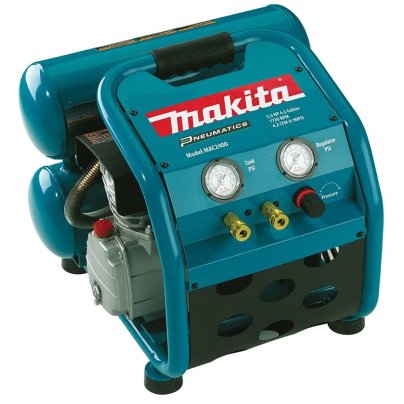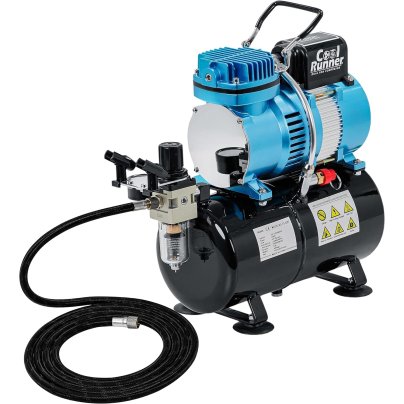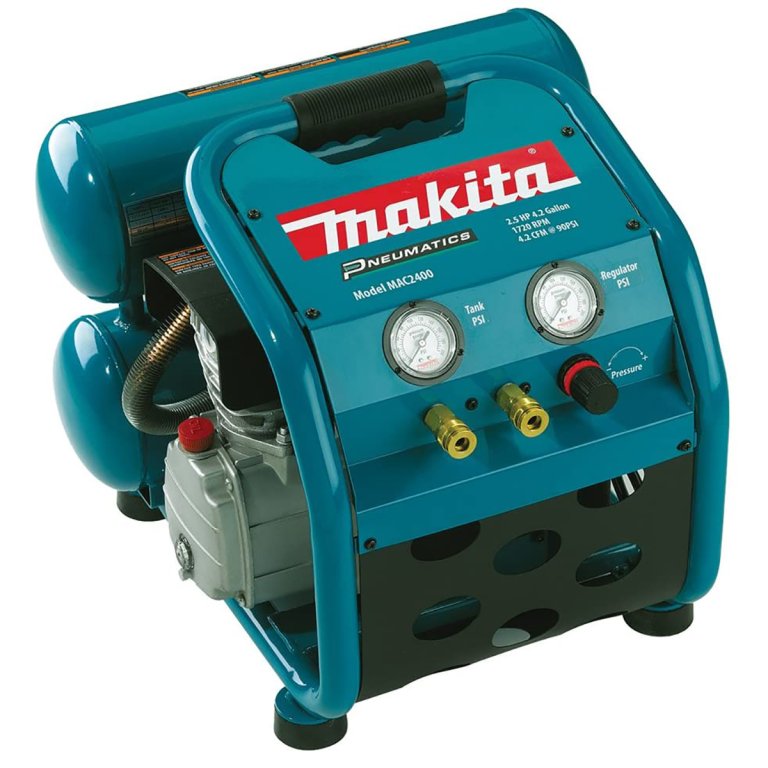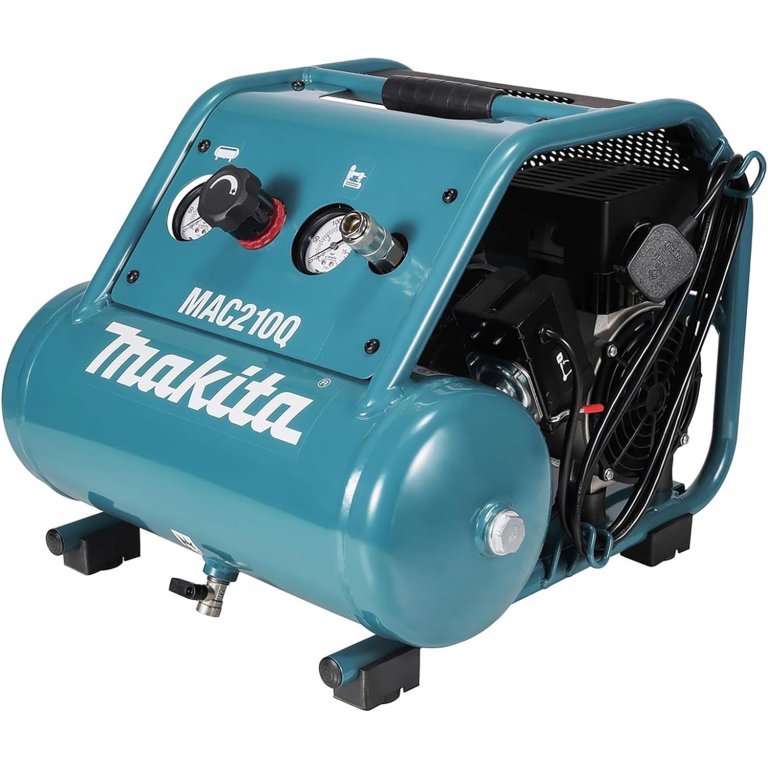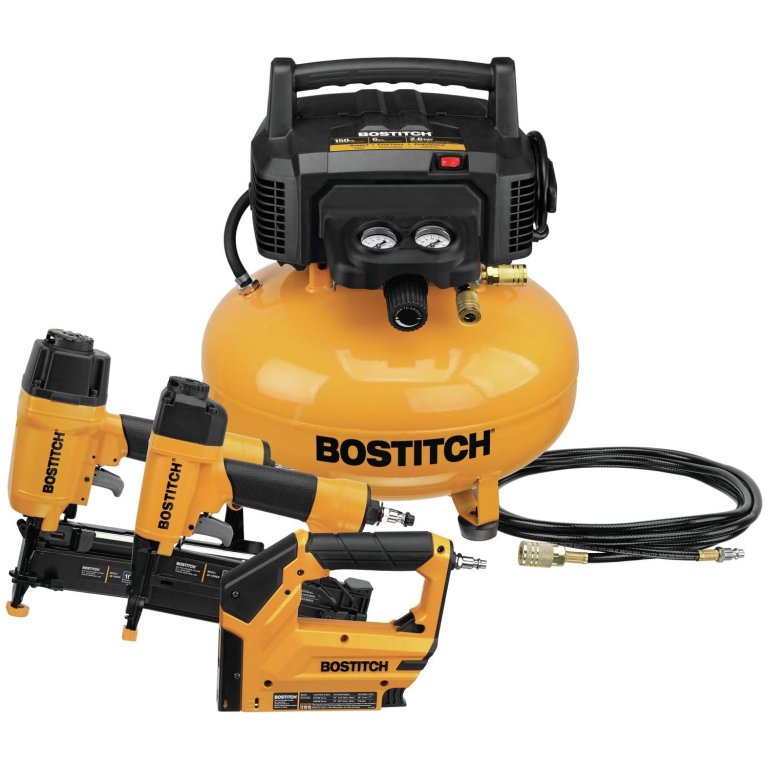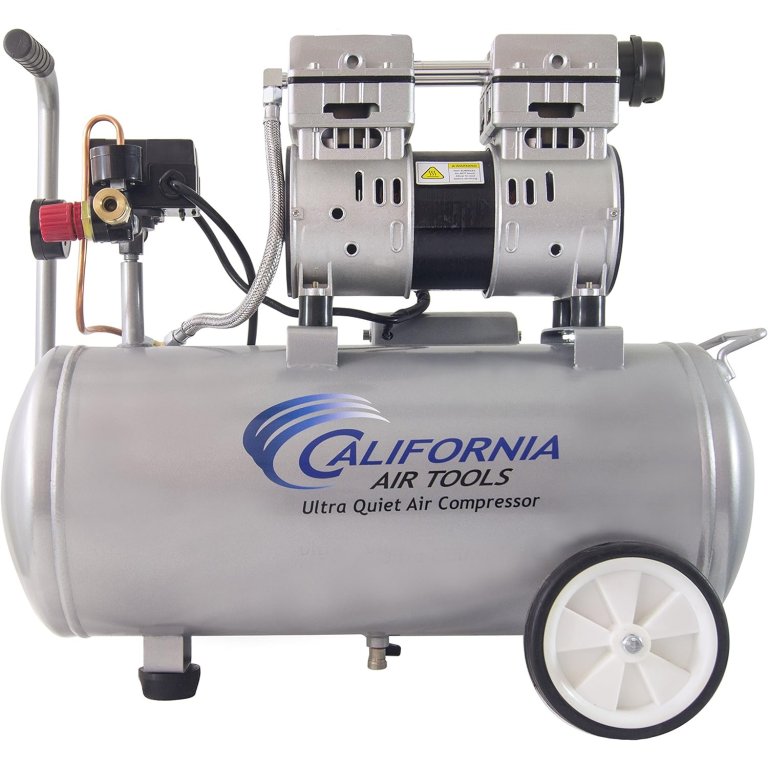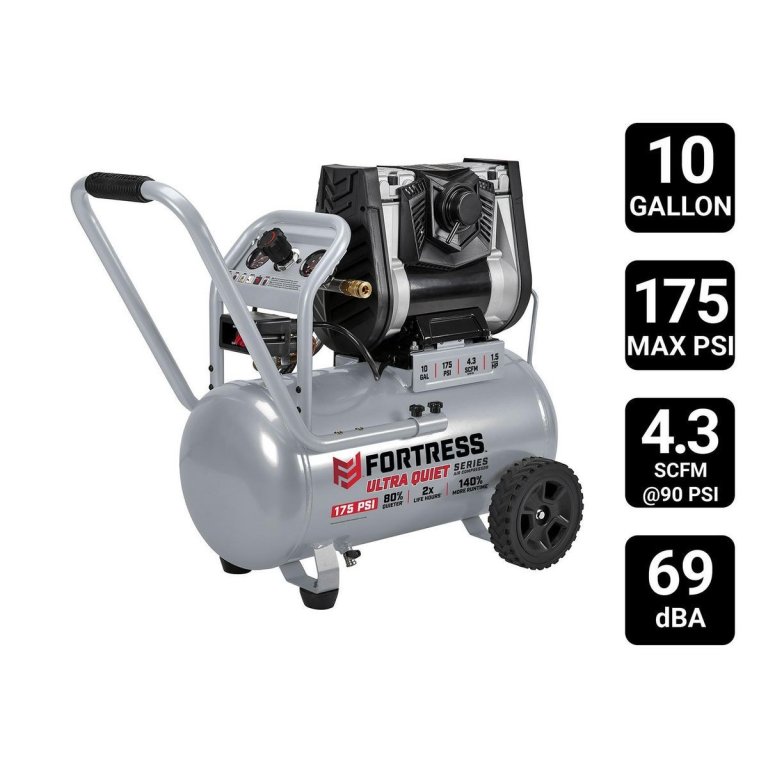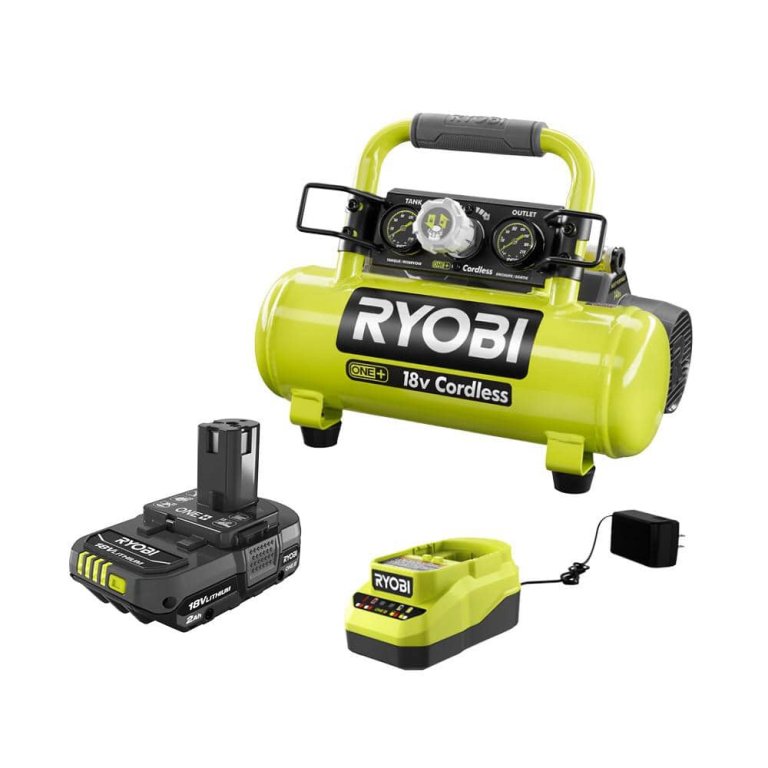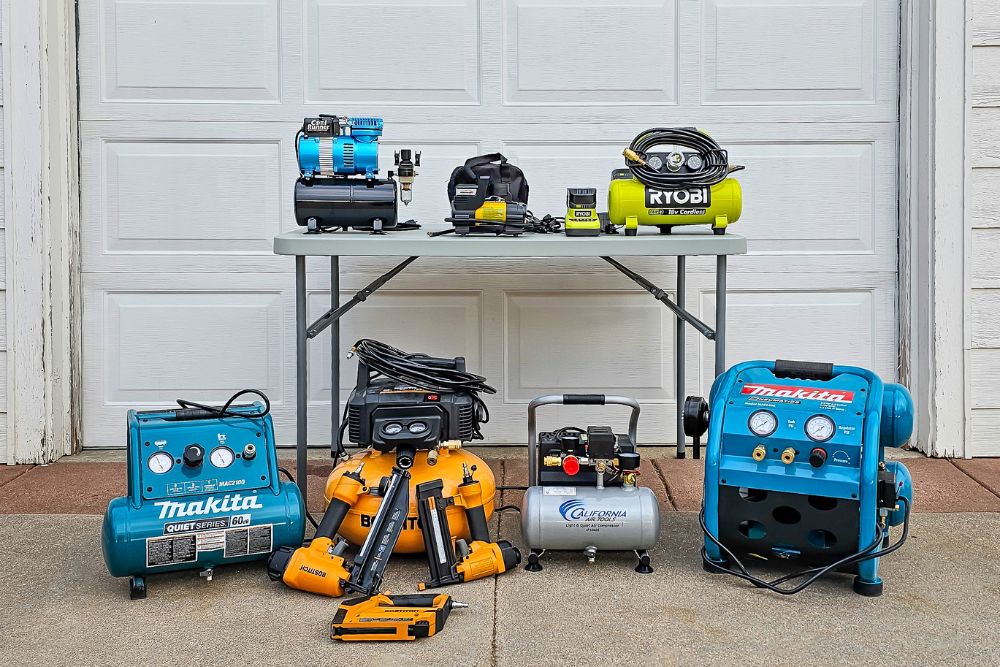
We may earn revenue from the products available on this page and participate in affiliate programs. Learn More ›
Pneumatic tools powered by a portable air compressor can save lots of time on various projects, whether at home or at the construction site. One of the biggest benefits of a portable air compressor is that it allows you to use lightweight power tools. Driven by an air compressor, pneumatic power tools don’t need to be equipped with a heavy motor of their own.
You can buy a range of high-quality pneumatic tools, but at the end of the day, an air-powered tool is only as good as the compressor powering it. We tested today’s most popular portable air compressors in our workshops and on jobsites to see how well they fared in real-world applications. We were surprised and impressed by some of the new models’ power and quietness.Read on to find out how the following models earned a spot in this tested lineup of today’s best portable air compressors.
- BEST OVERALL: Makita MAC2400 2.5 HP Big Bore Air Compressor
- BEST BANG FOR THE BUCK: Master Airbrush ⅕ HP Cool Runner II Air Compressor
- BEST COMPACT: Makita MAC210Q Quiet Series 1 HP Air Compressor
- BEST COMPRESSOR KIT: Bostitch 3-Tool Air Compressor Combo Kit
- BEST FOR INFLATING: EPAuto 12V DC Portable Air Compressor Pump
- BEST WITH WHEELS: California Air Tools 8010 1 HP 8-Gal. Air Compressor
- BEST MULTIPURPOSE: Harbor Freight Fortress 175 PSI Air Compressor
- BEST BATTERY-POWERED: Ryobi One+ 18V Cordless 1-Gal. Air Compressor Kit
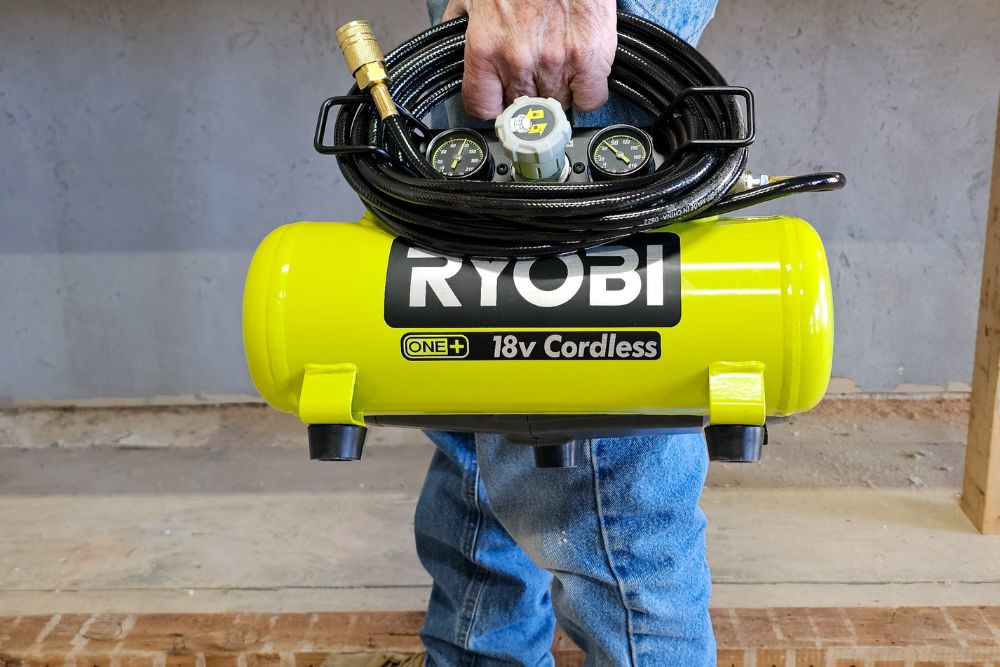
Before You Buy a Portable Air Compressor
Portable air compressors can be a tremendous help in both DIY and professional settings. However, a larger air compressor might be better when working in a shop scenario because it will generate greater and more consistent volume. If, on the other hand, you’re looking to bring the compressor with you, a portable model is the way to go.
How We Tested the Best Portable Air Compressors
With dozens of highly rated air compressor models to choose from, we needed to narrow the field to the top performers in various categories and test just those. We considered brand names to an extent; after all, reputable manufacturers such as Makita are known for their high-quality tools.
We narrowed the field further by only considering models that weigh 90 pounds or less. While many of our readers can easily lift and load heavier models on trucks, we felt 90 pounds was a good cut-off point, and we were looking for other portability factors, such as wheels and handles.
We assembled the models as they arrived, filled crankcases with oil (if necessary), installed air filters, and started them up. We then connected air-powered tools that were suitable for use with each specific compressor based on pressure requirements, and we used the tools as we normally would. We noted cycle run/recovery times, pressure consistency, and ease of use and paid special attention to portability factors. We awarded points based on a rubric: The better a compressor performed on a test, the more points it earned. After testing, we averaged the points to determine our top picks and award each product its own distinction based on its standout qualities.
Testing Stats
- Products tested: 8
- Hours spent testing: 20+
- Tests performed: 4
- Price range: $30 to $390
Our Top Picks
The following list is a roundup of the best-performing portable air compressors in our tests. While you’ll find a variety of power capabilities and intended uses, each one was a standout in our tests and earned its place on the lineup. One of these portable compressors is sure to be a good fit for your pneumatic tool needs.
Best Overall
Makita MAC2400 2.5 HP Big Bore Air Compressor
See ItPros
- Dual hose ports allow users to run 2 tools at a time for better workflow
- Simple to store when not in use thanks to its compact design
- Easy-to-read oil gauge makes it simple to keep an eye on the oil level
Cons
- Single regulator knob for both ports limits simultaneous dual-tool use to similar pressure requirements
Product Specs
- Power source: Corded, electric
- Tank size: 4.2 gallons
- Maximum pressure: 130 pounds per square inch (PSI)
- Cubic feet per minute (CFM) at 90 PSI: 4.2
- Weight: 77 pounds
Our Ratings: Ease of Use 5/5; Power 4.5/5; Noise 4/5; Portability 4/5; Value 5/5
Makita’s MAC2400 features a snazzy, twin-stacked tank design with 4.2 gallons of air volume. This is one of only a few oil-based models we tested, so we first filled the crankcase with oil (included), and then we installed the air filter. That was all, and it was ready to go.
With a 2.5-horsepower (hp) motor, this compressor can push 4.2 CFM at 90 PSI, so it’s well suited for inflating tires and powering brad nailers and staplers. We plugged it in, turned it on, and it quickly cycled up to its maximum, 130 PSI. We attached a nail gun and shot 12 nails quickly before the MAC2400 cycled on to replenish the tank’s air pressure. Not bad. We also tried it out with an impact wrench and loosened two lug nuts before it cycled on. So, it does have the power to run an impact wrench, but it will cycle frequently.
We like the compressor’s dual hose ports for running two tools at a time, and the built-in roll cage provides insurance against an accidental drop or fall. At 77 pounds, this compressor is near the upper end of being portable, but during our tests, its compact size and nonslip carry handle made it easier to lift and load. Our takeaway? The MAC2400 offers a solid combination of air power and portability for light-duty pneumatic tools.
Read our full review: Makita MAC2400 2.5 HP Big Bore Air Compressor
Get the Makita MAC2400 portable air compressor at Amazon, The Home Depot, or Ace Tool.
Best Bang for the Buck
Master Airbrush ⅕ HP Cool Runner II Air Compressor
See ItPros
- Lightweight and portable; easy to carry and use virtually anywhere
- Powers a standard airbrush for several minutes before cycling on
- Quiet operation, and the compressor comes with 2 holders for airbrushes
Cons
- Initially had a loose fitting that was causing the tank to lose pressure
Product Specs
- Power source: Corded electric
- Tank size: 0.79 gallons
- Maximum pressure: 57 PSI
- CFM at 90 PSI: N/A
- Weight: 12.35 pounds
Our Ratings: Ease of Use 4.3/5; Power 5/5; Noise 5/5; Portability 5/5; Value 4.7/5
Not all compressors are designed for running loud power tools, nor are they all pricey. Those who are looking for a lower-pressure unit—the type typically used for airbrushing fine designs on furniture, hardwood floors, or models—may want to consider the Cool Runner II by Master AirBrush. It’s an affordable option that’s ideal for those who need minimal pneumatic power.
Weighing in at just 12.35 pounds, the Cool Runner II was easy to carry around our workshop and out to the yard for testing. We plugged the compressor on, flipped the power switch, and it quickly cycled to its maximum 57 PSI capacity. However, when the cycle ended, we saw the needle on the pressure gauge slowly dropping. It shouldn’t have been doing that, but we couldn’t hear any air escaping. Still, there was a leak. We checked every fitting and sprayed water with dish soap on the connections. Sure enough, one started bubbling. After discovering the source of the leak, we tightened the nut, successfully halting the tank’s pressure loss.
To test the Cool Runner II, we attached an airbrush (not included) and loaded paint in the airbrush’s reservoir. We painted long, short, heavy, and light strokes. The Cool Runner II didn’t cycle on for more than 5 minutes, and when it did, we were able to continue painting while it recovered. The Cool Runner might be the ticket if you’re looking for a small, dependable compressor to run an airbrush. It is quiet yet powerful for its tiny size, and hopefully, you won’t need to tighten any nuts.
Get the Master Airbrush portable air compressor at Amazon, Walmart, or Michaels.
Best Compact
Makita MAC210Q Quiet Series 1 HP Air Compressor
See ItPros
- Does not take up much storage space thanks to its small footprint
- Relatively light weight coupled with a padded carry handle enhances portability
- Generates just 60 decibels (dB) of noise; very quiet by air compressor standards
- Well suited for light to medium tasks, including brad nailing, stapling, and inflating
Cons
- Not enough power or tank capacity to run heavier-duty tools
Product Specs
- Power source: Corded electric
- Tank size: 2 gallons
- Maximum pressure: 135 PSI
- CFM at 90 PSI: 2
- Weight: 45.2 pounds
Our Ratings: Ease of Use 5/5; Power 5/5; Noise 5/5; Portability 4/5; Value 4.3/5
If you’re looking for a portable, compact air compressor for light- to medium-duty tasks, such as brad nailing, stapling, and inflating, you won’t go wrong with the MAC210Q from Makita. This bright aqua-toned compressor weighs 45.2 pounds and is equipped with a sturdy roll cage that protects the motor from accidental drops or falls. It’s designed with a 2-gallon tank and has a maximum pressure of 135 PSI. It also features a nonslip padded handle that makes carrying it more comfortable.
We tested the MAC210Q for firing brads in hardwood trim and inserting construction staples in plywood sheeting. We also tried it with our airbrush, although this compressor is oversize for airbrushing. It worked well in all our tests and had a quick recovery time, so we didn’t have to stop firing brads or staples as it cycled.
Something that stood out to us is just how quiet the MAC210Q is while operating. It generates just 60 dB, making it well suited for installing decorative or detailed trim indoors where noise levels are a concern. It delivers 2 CFM at 90 PSI, so it’s not quite powerful enough to run an impact wrench or a pneumatic sander, but it’s a great little portable compressor that won’t take up a lot of room on the job or in storage. It measures just 17.375 inches long by 16.875 inches wide by 13.625 inches high.
Get the Makita MAC210Q portable air compressor at Amazon or The Home Depot.
Best Compressor Kit
Bostitch 3-Tool Air Compressor Combo Kit
See ItPros
- Delivers enough air power to run a framing nailer and other power-intensive air tools
- Comes with 3 high-quality Bostitch tools: a finish nailer, crown stapler, and brad nailer
- At 45 pounds, it’s lightweight enough to haul up on a roof
Cons
- Not a super-quiet air compressor; at 80 dB, it’s best suited for outside projects
Product Specs
- Power source: Corded electric
- Tank size: 6 gallons
- Maximum pressure: 150 PSI
- CFM at 90 PSI: 2.6
- Weight: 45 pounds
Our Ratings: Ease of Use 5/5; Power 4.5/5; Noise 4/5; Portability 5/5; Value 5/5
If you’re looking for a combination of power and portability, check out the 6-gallon pancake-style air compressor from Bostitch. It produces 80 dB of sound while running, so it’s not the quietest model we tested, but it delivered enough power to run a framing nailer, and we used it on the job for roofing.
We’re big fans of Bostitch—their staplers and small brad nailers are top-notch. Aside from the air compressor, this kit also includes three air tools: an 18-gauge brad nailer, a 16-gauge finish nailer, and a 0.375-inch crown stapler. To test the air compressor, we used it to power all three of these air tools, and it provided ample air power for each. The Bostitch compressor also comes with an air hose, which is nice since many models don’t.
With a maximum pressure of 150 PSI and a delivery rate of 2.6 CFM at 90 PSI, this portable air compressor produces enough power to handle a range of DIY and pro tasks. It weighs 45 pounds, making it substantial yet light enough to haul on a roof when installing sheathing and shingles.
In addition to testing with the three tools that came with the air compressor, we also used it with a pneumatic impact wrench. It delivered the power we needed to remove lugs. The Bostitch combo kit is a clear win for the manufacturer and an excellent pick for enthusiastic DIYers.
Get the Bostitch portable air compressor at Amazon, Lowe’s, or Walmart.
Best for Inflating
EPAuto 12V DC Portable Air Compressor Pump
See ItPros
- Lightweight, compact, and highly portable; ideal to stow in the trunk of a car
- Plugs into a car’s 12-volt port (cigarette lighter) for power anywhere
- Can be used to fill up bicycle tires as well as car tires
- Having an inflator-type air compressor in the car ensures you can fill up tires anywhere
Cons
- Not powerful enough to inflate heavy-duty truck tires
SPECS
- Power source: Corded electric, DC-12 volt
- Tank size: 0.92 gallons
- Maximum pressure: 70 PSI
- CFM at 90 PSI: N/A
- Weight: 3.7 pounds
Our Ratings: Ease of Use 4/5; Power 4/5; Noise 5/5; Portability 5/5; Value 4.5/5
If you’ve ever had a car tire with a slow leak, you know how nerve-racking it can be searching in vain for a service station with an air-pressure pump for fill-ups. The alternative is to check and fill up your tires with a shop compressor before you leave home—which is a good idea—but that won’t help you if you’re already driving in your car and you can’t find an air-pressure pump.
The solution? Stow the EPAuto 12V portable air compressor in your car’s trunk for easy tire inflating—no matter where you are. The EPAuto isn’t going to power any DIY tools, but it’s not designed for that. It’s designed to inflate automobile tires, and we found it quite capable of doing that. We purposefully released the air from some of our car tires and then used the EPAuto compressor to fill them back up to the recommended pressure.
The little unit comes with a 12-volt DC plug (for cigarette lighters in cars), and as soon as we plugged it in and flipped it on, it started cycling. It has a digital gauge, and we scrolled through several metric measurements to find the PSI level. It comes with a valve for filling auto and bicycle tires, and we filled up both.
It delivers a maximum of 1.06 CFM, which is enough to fill most types of car tires and bike tires but not quite enough to fill heavy-duty truck tires. It weighs just 3.7 pounds and comes with a 12-foot plug-in cord, so you’ll be able to reach any tire on your car.
Get the EPAuto portable air compressor at Amazon or Walmart.
Best With Wheels
California Air Tools 8010 1 HP 8-Gal. Air Compressor
See ItPros
- Large rubber wheels make it portable enough to roll around a workshop or jobsite
- High-volume tank offers plenty of working time despite its relatively light weight of 48 pounds
- Oil-free pump means less maintenance and no need to worry about fumes or spills
- Suitable for various DIY tasks, from firing brads and staples to light-duty painting
- Quiet operation makes it usable indoors and in other noise-sensitive environments
Cons
- No built-in roll cage; if it falls, there is a chance it can sustain damage
- Limited power for running high-capacity pneumatic tools or powering heavy-duty spray painting
Product Specs
- Power source: Electric
- Tank size: 8 gallons
- Maximum pressure: 120 PSI
- CFM at 90 PSI: 2.2
- Weight: 48 pounds
Our Ratings: Ease of Use 5/5; Power 4.5/5; Noise 4/5; Portability 5/5; Value 5/5
The California Air Tools 8010 is an 8-gallon horizontal compressor that can go anywhere it’s needed. It has two rubber wheels and a pull handle. We found it simple to grab the handle and pull it around. Plus, at 48 pounds, it’s still potentially light enough for one person to lift it into a truck bed or carry it up a set of stairs.
The 8010 is an oil-free air compressor, so the only setup we needed to do was to attach the wheels, which took about 2 minutes. The compressor delivers 2.2 CFM at 90 PSI, which makes it great at powering brad nailers and staplers, and because it has a hefty 8-gallon tank, it’s also suitable for light-duty paint spraying. We tested it for all three of these applications. It excelled at shooting brads and staples into hardwood and plywood, respectively, and then we attached the paint sprayer.
When we deployed a fine spray of paint, the 8010 did great—it kept up nicely, and even when it cycled, we were able to continue spraying. It didn’t do quite as well when we tried some heavy-duty paint spraying. When it cycled, we ran out of power for a bit, which is a big no-no in painting.
One of its most notable qualities is its quietness while operating. It generates just 60 dB of noise, so it can be used in spaces where noise levels must be limited. We found the 8010 to be a great choice for a portable DIY compressor.
Get the California Air Tools portable air compressor at Amazon, Lowe’s, or The Home Depot.
Best Multipurpose
Harbor Freight Fortress 175 PSI Air Compressor
See ItPros
- Quiet startup and operation compared to traditional air compressors
- Well-suited to several tasks, including nailing, inflating, and blow cleaning
- Thanks to the never-flat tires, no need to fill up the tires before rolling the unit
Cons
- Relatively heavy at 83.3 pounds, but rolling is doable via the handle and wheels
- Not a quick-recovery compressor, but still more than sufficient for many pneumatic uses
Product Specs
- Power source: Corded electric
- Tank size: 10 gallons
- Maximum pressure: 175 PSI
- Standard cubic feet per minute (SCFM) at 90 PSI: 4.3
- Weight: 83.3 pounds
Our Ratings: Ease of Use 4/5; Power 4.5/5; Noise 5/5; Portability 4/5; Value 5/5
If you want to seriously boost your air power, we recommend Harbor Freight’s 10-gallon Fortress air compressor, which delivers enough pressure to operate various power tools, including pneumatic nailers and other medium-duty air tools.
Since it has an oil-free pump, all we had to do was attach the large never-flat tires, and it was ready to start testing. Weighing 83.3 pounds, this was one of the heaviest models in our portable air compressor tests, but it’s easy to pull the Fortress along using the handle—even over uneven gravel.
The Fortress delivers 4.3 SCFM at 90 PSI. This measurement is similar to CFM but factors in temperature and air density, making it slightly more accurate. It also offers a maximum pressure of 175 PSI, so it’s suitable for many DIY tasks. The Fortress successfully fired nail after nail without pause and powered a light-duty paint sprayer. It lagged a bit when we attached our heavy-duty paint spray gun, leaving us with a few drips after about 5 minutes when it couldn’t recover as quickly as we were spraying.
As a small garage or shop compressor, the Fortress is just the ticket. While it might not offer enough air power for commercial paint-spraying jobs, it’s an excellent option for a DIY compressor and will easily power medium-duty pneumatic tools.
Read our full review: Harbor Freight Fortress 175 PSI Air Compressor
Get the Harbor Freight portable air compressor at Harbor Freight.
Best Battery-Powered
Ryobi One+ 18V Cordless 1-Gal. Air Compressor Kit
See ItPros
- Lightweight and highly portable air compressor thanks to its battery power
- Small, but has a maximum 120 PSI, making it suitable for various tasks
- Can be used in remote locations where electricity is not available
Cons
- Limited battery life—about 1 hour if used consistently—which may be insufficient to complete some tasks
Product Specs
- Power source: Rechargeable battery
- Tank size: 1 gallon
- Maximum pressure: 120 PSI
- CFM at 90 PSI: 0.5
- Weight: 14 pounds
Our Ratings: Ease of Use 5/5; Power 4.5/5; Noise 4/5; Portability 5/5; Value 4.5/5
Having a rechargeable battery to rely on instead of having to plug into an outlet makes the Ryobi One+ air compressor ultraconvenient. This light-duty compressor features a compact 1-gallon tank and weighs just 14 pounds, yet it can still provide up to 120 PSI, making it capable of powering brad nailers, inflating car tires, and running airbrushes. We tested it for all three of those purposes.
We connected our brad nailer and fired dozens of nails into hardwood trim. We didn’t fire the brads at a rapid pace, as in bump nailing; instead, we fired one every 5 to 10 seconds to simulate a trimming scenario. We didn’t test our light-duty paint sprayer; the Ryobi One+ comes with a relatively low CFM (0.5 at 90 PSI), so we knew it wouldn’t be up for the task. However, we connected our airbrush, and this little Ryobi compressor powered it wonderfully. It never ran out of pressure, so we were able to paint continuously, even while the compressor cycled.
One of this air compressor’s greatest benefits is that it can be taken anywhere—even to sites with no electricity—and it will power light-duty tools. The downside is that during our testing, the low-capacity 2-amp-hour battery that comes with the compressor only provided 1 hour of power before needing a recharge. It took just about 2 hours to charge the battery. Nonetheless, if you need a compressor for light-duty work and don’t have access to electricity, the Ryobi is just the ticket.
Get the Ryobi portable air compressor at The Home Depot.
Jump to Our Top Picks
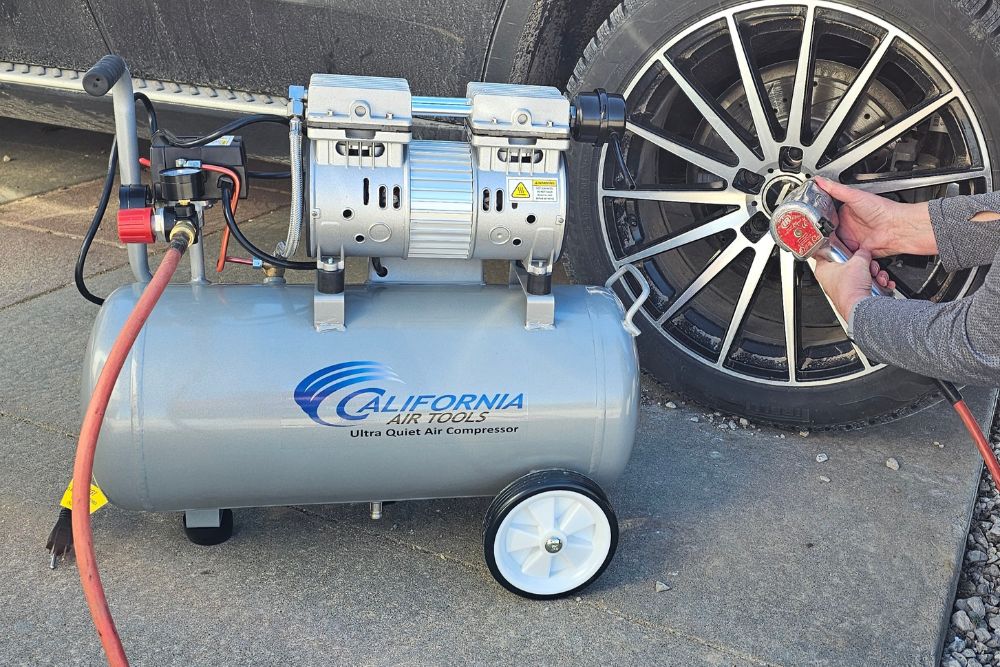
What to Consider When Choosing a Portable Air Compressor
After considering how to choose the best power source to suit the project at hand, bone up on important considerations such as power, maximum pressure, and tank volume. Understanding these aspects will help narrow down the options to find the best portable air compressor for the job, whether it’s filling a flat tire or running a nail gun.
Power Source
Before purchasing a portable air compressor, consider the power source. Portable air compressors run on either electricity or gasoline. Each power source has its pros and cons, explained below.
Electric
Electricity is the more popular power source for portable air compressors. These machines plug into standard outlets and use an electric motor to pressurize the tank. They’re usually reasonably lightweight, and electric motors require very little maintenance throughout their lifetime.
Electric portable air compressors are a solid choice for home garage workshops and renovation projects, as there is generally an electrical outlet nearby to plug into. They don’t create exhaust, so they’re suitable for indoor use without worrying about carbon monoxide poisoning.
However, electric compressors do have a few shortcomings. They usually aren’t serviceable because replacing the motor, pump, and necessary seals will often cost as much as buying a new compressor. Also, they’re not useful on construction projects that haven’t reached the electric phase unless the site has a heavy-duty generator to supply enough power.
A cordless compressor may be a good choice for those sites without electricity. These compressors run on a rechargeable lithium-ion battery to fill their tanks but otherwise work the same as a standard electric compressor. However, having more than one rechargeable battery on hand is a good idea.
Gas
Gas-powered portable air compressors use internal combustion engines to pressurize their air tanks. The quality of these compressors depends heavily on the manufacturer of the gasoline engine. The best-known manufacturers are Honda, Briggs & Stratton, Kohler, Generac, Subaru, and Kawasaki.
Gas-powered compressors can operate virtually anywhere as long as there’s fuel in the tank. However, they tend to be heavier than electric model compressors, making them somewhat less portable. They also require more maintenance, as they’ll need winterizing, an occasional oil check, and fuel filter and spark plug replacements from time to time.
While gas-powered portable air compressors are fine to use on outdoor construction sites and other places without power, they cannot be run inside a closed space, as these engines produce exhaust and can run the risk of causing carbon monoxide poisoning.
Power
Air compressor motors are measured in horsepower ratings, and the machine’s power has a lot to do with its capability. While most air compressors have enough power for general needs, the more powerful the compressor, the faster it will fill its tank with air.
Horsepower can also affect how much maximum pressure a compressor can produce. Small electric motors should have at least 0.5 hp, while gasoline-powered options can benefit from as much as 5 hp engines.
Again, it’s important to consider the power source. If you’ll be working mostly on renovation projects, an electric air compressor will likely suffice. But when taking tools on the road to remote locations, a gas-powered compressor might be worth considering.
Pressure and Airflow
Portable air compressors have varying maximum pressures, which are measured in pounds per square inch. Some might pressurize to 120 PSI, while others can produce up to 150 or even as high as 180 PSI. Users can adjust the outgoing pressure with the regulator knob, checking the pressure gauge to adjust it to the correct pressure.
Maximum pressure is important to keep in mind because some tools require more pressure to work properly. For instance, most impact wrenches won’t operate until they reach 60 PSI or so. Some nail guns may also require a bit more pressure. While a nail gun may have a working range of 90 to 120 PSI, driving long nails into extremely wet or dense wood might require maximum pressure. As a general rule, most compressors with more than 120 PSI will typically be fine for projects around the house or workshop.
Airflow may be the most important metric manufacturers provide with their air compressors. Measured in CFM, this metric explains how much air the operating compressor can put out while maintaining pressure.
Essentially, a compressor needs to be able to run and maintain pressure for as long as a tool is in use. If a tool drains the pressure out of the tank, work will have to stop and users must wait for the tank to build enough pressure to power the tool again.
While the proper CFM rating will depend on the tools the DIYer will use, most of the CFM measurements provided are at 90 PSI. For basic power tools, such as nailers or staplers, look for a compressor that can maintain at least 2.0 CFM at 90 PSI.
Tank Size
A compressor tank’s size, measured in terms of volume, determines how much compressed air it can hold. It also determines how often the compressor will cycle and how long it can run for.
Nail guns work with short bursts of air, requiring very little volume; 4- or 5-gallon tanks are usually enough for DIY projects. Conversely, air power tools like impact wrenches, cutoff wheels, and pneumatic reciprocating saws use much more air as users hold their triggers down continuously. For this reason, they require larger tanks; otherwise, they’ll have to cycle on and off frequently to maintain the tank pressure. In this case, 20-gallon tanks and larger are most helpful for running air tools and filling large truck tires.
Noise Level
Traditional air compressors were notoriously loud, but manufacturers have taken steps to lower the decibel level in recent years by incorporating thicker-gauge steel, reducing friction and vibration in the motor, and using sound-reducing enclosures around the motor and pump.
Most of today’s air compressors generate noise levels between about 40 and 92 dB, which ranges from approximately the noise level of a quiet library to as loud as a gas-powered lawn mower. They’re not consistently noisy—they typically generate sound only during their recovery cycle, but when they cycle on, the noise can be startling if it’s loud.
We also recently tested quiet air compressors with models producing no more than 75 dB, comparable to the noise level of a vacuum. Working in a noisy environment can be uncomfortable and even lead to hearing loss if the noise is too loud for an extended period.
If your air compressor is louder than you’d like, try placing it on a rubber mat or use a long air hose and move the compressor farther away—to a different room, if possible—if you’re working indoors.
Weight and Portability
To be considered portable, an air compressor should be light enough to lift into the back of a truck, onto a shelf, or be wheeled about. Suitable weight depends on the user’s strength. For some people, a 35-pound compressor might be too heavy to lift, while others will pick up a much heavier compressor and load it in a truck bed without thinking twice.
Generally speaking, pancake compressors (models that use round air tanks with motors atop) weigh about 30 pounds, making them a great choice for portability. Some double-tank compressors offer more volume but weigh substantially more. We placed a lot of importance on portability in our testing; we only selected compressors that weigh less than 90 pounds, and for those toward the top end of that range, we made sure they came with wheels or sturdy handles for lifting.
Additional Features
Some additional features can improve an air compressor’s utility and potentially extend its lifespan.
Built-in roll cages are steel or aluminum frames that protect the compressor. They’re especially helpful when a portable compressor falls from a truck tailgate or when someone drops a heavy item on it.
Oil-cooled air compressors use oil to lubricate the compressor pump. This helps them stay cool, extending their lifespan. These models may include low-oil sensors that shut the machine down if there isn’t enough oil, which helps prevent the machine from running dry and overheating—two situations that could kill a compressor before its time. Oil-cooled models are still popular, but oil-free versions are surging in popularity due to their lower maintenance requirements.
Other additional features include easily operated petcock drain valves that allow for draining a compressor’s water buildup easily, quick-connect adapters, and thermal overload protection.
Accessories
Occasionally, an air compressor might come with an accessory kit. This kit can be a great start for DIYers who don’t already have a myriad of air tools and fittings in their shop. These kits often come with tire inflators, quick-connect fittings, and blow-off chucks.
It’s sometimes possible to get a kit that includes a length of air hose or a set of nail guns. Some sets on the market include the tools and fittings necessary to get up and running, significantly decreasing the amount of shopping you would have to do otherwise.
If an air compressor doesn’t come with a set of accessories, DIYers can find kits that include the basic tools necessary to set up the compressor, such as this accessory kit.
FAQs
If a portable air compressor seems like it could be a big help for your projects, but you still want more info, consider the answers to some commonly asked questions below.
Powered by a motor, the piston of a portable air compressor draws outside air into a chamber and then stuffs it into a tank to compress it. It continues doing so until the pressure builds up enough to power pneumatic tools and inflate tires.
Most portable air compressors come set up out of the box. If one doesn’t, the most you might have to do is to install a quick-connect on your hose port, or attach the wheels or handle.
To use an electric compressor, simply plug it into an electrical outlet and flip the power switch on. Once the compressor builds up pressure, you can use the built-in pressure regulator to adjust the outlet PSI to match the tool’s requirements.
For gasoline-powered compressors, fill the fuel tank and check that the engine has oil in it. Flip the power switch to the on position and pull the pull-start cord until it starts.
The different shapes of compressors aren’t a functional design concern, so manufacturers can get creative with their designs. Sometimes, separating the tank into two smaller tanks allows the compressor to have a lower center of gravity, making it more portable.
Other times, the designs simply take up less space. For example, a horizontal compressor can fit under a workbench, while a vertical compressor fits better in a corner. Whether you’re looking for a home air compressor or one to take on the jobsite, consider the shape that best fits your space and portability needs.
This depends on the task at hand. Inflating bike tires and sports balls does not require much pressure. On the other hand, powering pneumatic tools with an air compressor will usually require 90 PSI or more to operate effectively. If you’re inflating something, look for the maximum pressure, which is usually printed on the item near the inflation valve.
An inflator is an air compressor—it just isn’t designed for powering beefy tools. Essentially a miniature air compressor, an inflator typically comes with a 12-volt DC plug for connecting to an automobile’s 12-volt port when the user wants to air up the tires. It may not provide enough pressure to fill large truck tires, but most inflators are capable of filling the tires of passenger cars. Some inflators even come with built-in tire pressure gauges.
Meet the Tester
Glenda Taylor is a product tester and writer specializing in the construction, remodeling, and real estate industries. She and her husband own a general contracting company, and Taylor is experienced in both residential and commercial building applications. She tests a wide range of power tools as well as other home improvement, household, and lawn-and-garden products.
Additional research was provided by Tom Scalisi.
